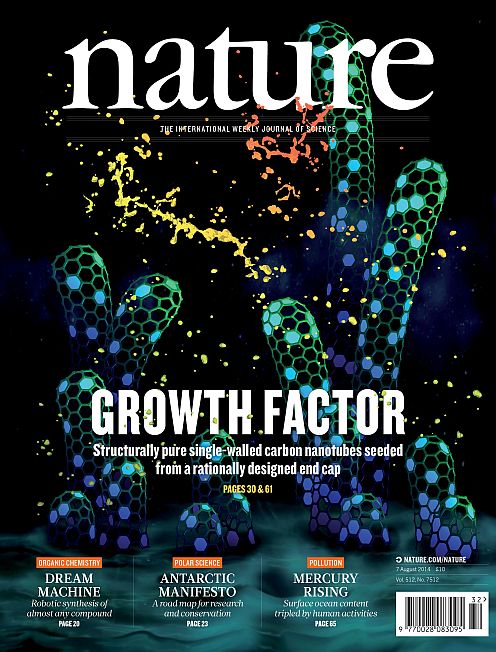Research of Empa scientists on the cover of "Nature"
Synthesis of structurally pure carbon nanotubes using molecularseeds

|
Source: Nature, http://www.nature.com/nature/journal/v512/n7512/index.html |
||||
|
For 20 years, carbon nanotubes (CNTs) have been the subject of intensive fundamental as well as applied research. With their extraordinary mechanical, thermal and electronic properties, these tiny tubes with their graphitic honeycomb lattice have become the paragon of nanomaterials. They could help to create next-generation electronic and electro-optical components that are smaller than ever before, and thus to achieve even faster switching times. |
||||
|
As uniform as possible |
||||
|
|
||||
|
||||
| Scanning tunneling microscopy images the precursor, the «folded» end cap, and the resulting carbon nanotube, together with the corresponding structural models. (Source: Empa / Juan Ramon Sanchez Valencia) | ||||
|
|
||||
|
For some time, the Empa team working under the direction of Roman Fasel, Head of the "nanotech@surfaces" Laboratory at Empa and Professor of Chemistry and Biochemistry at the University of Berne, has been investigating the subject of "how molecules can be transformed or joined together to form complex nanostructures on a surface". For instance, by means of "bottom-up" synthesis, the Empa researchers managed to produce specific nanostructures such as defined chains of "buckyballs" (essentially, CNTs shrunk into ball form) or flat nanoribbons on gold substrates. "The great challenge was to find the suitable starting molecule that would also actually 'germinate' on a flat surface to form the correct seed," says Fasel, whose team has gained broad expertise in the field of molecular self-organisation over the years. Finally, their colleagues at the Max Planck Institute in Stuttgart successfully synthesised the suitable starting molecule, a hydrocarbon with no fewer than 150 atoms. |
||||
|
Molecular origami |
||||
|
|
||||
|
||||
| On a Platinum surface, the planar hydrocarbon precursor folds into an end cap, that in turn acts as seed for the growth of a well-defined carbon nanotube. (Source: Empa / Juan Ramon Sanchez Valencia) | ||||
|
|
||||
|
It works!
The project was supported by the Swiss National Science Foundation (FNSNF). |
||||
|
||||
| You can find more pictures about SWCNTs on Empa’s Flickr-Stream https://flic.kr/s/aHsk1rFNDy | ||||
|
|||
|
|||
|
|||



